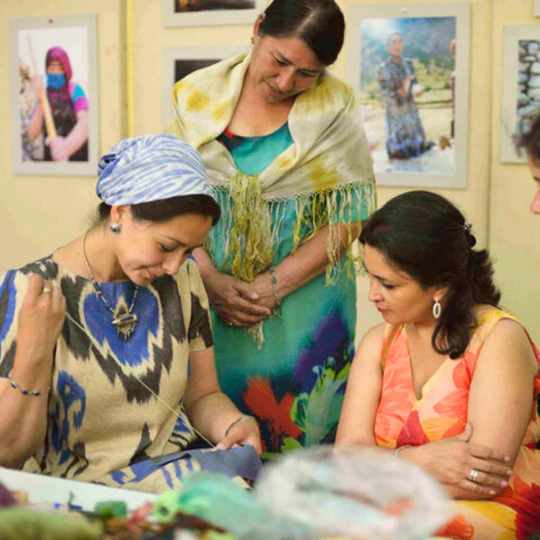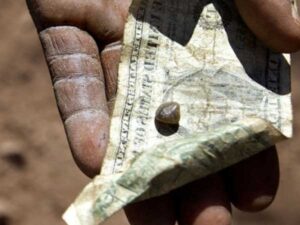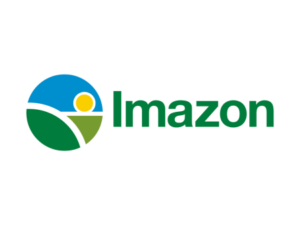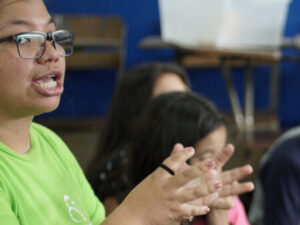HoonArts is a social impact enterprise focused on bridging the gaps between the West and Central Asian art and culture. It builds cultural awareness and facilitates fair-trade sales of the work of artists and artisans in Uzbekistan, Kyrgyzstan, and Tajikistan.
Rikki Quintana of HoonArts spoke with Ashley Hopkinson on December 5, 2023. Click here to read the full conversation with insights highlighted.
Ashley Hopkinson: Hi, could you please introduce yourself, tell me about the problem that HoonArts was setting out to solve, and how you are actively solving that?
Rikki Quintana: I’m Rikki Quintana. I’m the founder and CEO of HoonArts Fair Trade, which is a social impact enterprise focused on bridging the gaps between the West and the art and culture of Central Asia.
I worked directly with several small artisan groups in Tajikistan, Uzbekistan, and Kyrgyzstan. It was two-sided. On the one hand, the artisan groups I work with are small artisan groups. They provide income to a lot of primarily rural women. But to continue to do that and have a greater financial impact locally, they needed access to the western market. That was one of the problems that I wanted to tackle with HoonArts. Another problem that has only grown over the last nine years that I’ve been involved is the divisiveness in the world and the lack of knowledge and understanding of other cultures; cross-cultural communication. For me, the strongest motivation has been to build bridges in a way that people on both sides can see our common humanity and appreciate the beautiful diversity. I’ve always viewed art as not the be-all and end-all of the business, but the hook that allows people to start a conversation.
Ashley Hopkinson: How are you reaching the people that you’re serving and how are you engaging with them?
Rikki Quintana: On the maker’s side, I was extremely lucky. I met someone who came to Albuquerque as part of a US government-sponsored exchange delegation in 2014, and learned that no one in the US was working to build a market for Tajik candy crafts. At a farewell party, I found myself making my little farewell speech about, “Well, I’ll do it. I’ll open that market.” And thank God I didn’t know what I didn’t know. I spent the first thirty-one years of my professional career as a business attorney. I had no aspirations to be an entrepreneur when I retired from practicing law. But I love art, I love international connections, and I saw a need. That original delegate connected me with artisans in Tajikistan, which was the way I began. Then subsequently, I connected with artisans in Kyrgyzstan and Uzbekistan through working at their booths at the International Folk Art Market in Santa Fe.
In terms of ongoing communication, like everywhere else in the world, they’re very tech-savvy. They may not have broadband, but I first learned about alternative means of communication from my artists. My artists said, “You need to be on Viber, Rikki, so that we can communicate.” Mostly we work online. I have been to Tajikistan and Central Asia twice, but it’s more to solidify the relationships. My last trip I led a small tour. I have another one planned for the spring. It’s to build person-to-person relationships rather than for business development.
On the buyer side, it is the world of Amazon. It is getting harder and harder to get connected with people on a digital platform unless you’ve got a lot of money for paid advertising or a lot of money for paid influencers. I’ve devoted a lot of time, money, and energy over the last five years to really try to break in online, and I’ve basically given up because I simply don’t have the resources to try to compete with the algorithms.
Skoll has funded some projects through Catalyst Market. Catalyst Market is a multi-vendor, vendor-owned e-commerce platform, for sustainable businesses ethically sourced. It’s not limited to fair trade, but it includes fair trade. There are hundreds of vendors on the platform now, and the fee for participation is simply 6% of any sale. It’s the first widespread platform that is not designed to make money for the platform. It is designed to benefit the vendors, and Skoll has provided funding for Catalyst Market. It just launched a little over a year ago. It’s a new market, but it suffers from exactly the same problem. It cannot get traction. I’ve had a handful of sales. You just can’t get through the noise on the internet.
Ashley Hopkinson: What makes HoonArts distinctive? I know it’s definitely the connection to the other worlds, Kyrgyzstan, Uzbekistan, but what would you say makes HoonArts stand out in this space?
Rikki Quintana: I work to bring the experience of the culture of Central Asia to the West rather than just pretty products. I have a YouTube channel. I do a lot of online educational programs. I’ve done a number of ‘Live from Central Asia’ webinars, which is always challenging, because it’s a 12-hour time difference. I do presentations and talks. I’m always striving to provide an authentic access to the culture so that people can experience it. I liken it to the difference between looking through the window and actually stepping through the door.
That’s what I view as our most distinctive feature. It is extraordinarily challenging. After investing in a couple of very high-end business coaching programs, learning about marketing, spending lots of time and energy, I basically concluded that at the current scale, there’s no way I can build my audience online. What I have to do is build my audience through personal relationships. Even that is challenging, because I live in a part of the country that doesn’t have as big a market. It’s far from the major hubs. Shipping is extra expensive. The part of the world my artisans live in is literally 12 time zones away. Everything has to be shipped by air freight. The time difference is challenging, but I’m really now leaning into building personal relationships, building a personal network. Not that I don’t, I am not shutting down my website or my e-commerce site, but that’s not the access point. I have given up on having that be anything other than a convenience device for people I connect with through my personal network.
Ashley Hopkinson: I wonder if you can share an example of the impact of your work or something that illustrates the impact of your work. Have you had an experience with either a buyer or an artisan or someone who has come on one of your tours that kind of reflects why you’re still in it?
Rikki Quintana: Well, I’ll tell you one story. Measuring quantitative impact is extremely challenging at my scale, and it takes time, and it’s just me. But it’s a topic that I’m very interested in. I was part of a group within the Catalyst Market community on impact measurement and storytelling. One of the things as I began to discuss the topic of impact was to start asking my artisans what is the impact they value the most from working with me rather than me as the North American white savior swooping in to make life better for them? I was actually surprised to hear, in particular, from one of my artists in Tajikistan who has strong English skills. She basically said that it was my continual support for cultural heritage preservation. Not the dollars, but the cultural heritage preservation, the sharing of knowledge, both. She teaches the artisans that she works with the history and meaning behind the artistic work they do. During the Soviet period, a lot of that was lost because Moscow did everything they could to wipe out that sense of cultural heritage and cultural identity. Sharing that by both supporting their efforts and learning and sharing that education, in the West, has been a major impetus to continue their efforts. Their work is valued for the culture behind it, the heritage behind it, more than the dollars.
Another example associated with that is that we’ve done a lot of product development, some of which have caught on in the West and others have not. The work on color design quality finish work has helped the artists really focus on those aspects. Even if the products haven’t sold really well in the US through HoonArts, they have become much better sellers to the expat and international traveler population in Central Asia. Central Asia is a part of the world. I laughingly say it’s one of those places where there’s no such thing as too many colors or colors that don’t go together. The average American doesn’t resonate with that. It needs a narrower color palette, a little less busy.
There are products that we have done here that we developed specifically for HoonArts, like one artist does wood carving. We developed some specific jewelry. It’s a family group, and they originally focused just on combs. Well, we’ve now done some jewelry earrings and barrettes that they sell locally. Because we focus on the quality and the design, their products sell well when visitors or the diplomatic community, the expat community is shopping because it’s still authentic. The patterns are still authentic, but the quality, there’s a focus on quality and where color is involved, it’s a toned down, more Westernized version. I’ve learned the American palette is narrower than Central Asia, but a lot wider than Europe. I look at the colors that some of the artists do for Europe. It’s like, “Oh my god, that’s so boring. There’s nothing but black, white, gray and brown.”
Ashley Hopkinson: It sounds like by having conversations with the artisans themselves, you’ve learned a lot about your own impact measurements. This is a good segue because I was going to ask you how you measure success and what’s the evidence for you that you’re making progress?
Rikki Quintana: The sales here, obviously sales locally, and also the local focus on cultural preservation, and the extent to which the artists and teams both build the self-confidence of the individual artists and build their sense of identity and self-worth. This emerges from their deeper understanding of the culture and knowing that people in the West are interested in what they’re doing and admire what they’re doing. Measurement is a very challenging effort at the small scale and because of the limited resources I have. It’s something I’m focusing on. But for example, all of my lead artisans, except for the family carving group, they all work multiple jobs. They don’t operate on 8 to 5 time schedules. They are typically working 16, 18 hours a day doing multiple jobs. Even for them to schedule the time to have a conversation about impact measurement, much less designing a measurement tool is in many ways a burden.
Ashley Hopkinson: This is probably just because I’m a journalist and I love stories, but I find stories of impact really powerful. I love what you said about cultural heritage and preservation and sharing of knowledge.
Rikki Quintana: Storytelling is a huge part of what I do. I have a blog and a regular newsletter that’s all about storytelling. In fact, Skoll provided funding for one of these initiatives around storytelling and social impact. And we put together an impact and storytelling toolkit, which is available for free to the world basically. It was four different authors in four different countries that put this together. A couple of us, me and the artist who is based in the Netherlands, are just about to launch registration for an impact storytelling challenge. We’re also going to do a five-day challenge to plan impact storytelling; tell your enterprise’s story of impact, because it is very challenging to find the time and the resources to do that well.
Ashley Hopkinson: My family is from Guyana, South America, and there are great artisans there, lots of wood carving and just beautiful artwork. If I was to try to start an enterprise to sort of connect Caribbean and South American artistry to the Western world in a similar way, what advice would you give to someone who wants to start that kind of connective work the way you’re doing it?
Rikki Quintana: Well, first thing I would say is be prepared for a long game. Unless you have extraordinary luck and connect with the right people who can provide either financial resources and/or access to people of influence, it will be a long haul. It is getting harder and harder. The retail market is changing. People are spending less money on artisan-made products. People are spending less money on stuff. They’re interested more in experiences. The largest segment of my purchasing audience are women, I would say 55 and up. As they retire, they downsize and they’ll say, “Oh, I love your stuff. It’s so gorgeous. But I don’t go anywhere anymore. I don’t go out. I don’t have a place to wear your beautiful silk scarves or your earrings. I’m downsizing my house and my kids don’t want my stuff that I’ve collected from my travels around the world.” It’s a very niche market. You need to be aware of that and be prepared for that.
I would say in retrospect, I would perhaps have done better financially if I had spent more time at the beginning building personal relationships in the community, which takes an enormous amount of time. When you’re starting, it’s like, oh, I got to build a website and I got to get photos and I have to do a newsletter and I have to do all these millions of things and figure out what I’m doing. I think I would advise people starting in this area, at the beginning now, I would say focus on relationships. I think you could start initially just at the very ground floor. When you find people who love your stuff, have extended conversations with them about what they love about your stuff. What makes it something they’re willing to spend money on.
It’s tough. I can remember when I started, “Oh, you need to define your target audience and you need to figure out your ideal customer.” It’s like, well, I don’t know my ideal. I don’t have any sales. How do I know who’s going to buy my stuff? But you will find people early in the process. When you stumble upon those early fans who love your stuff, talk to them about what makes it special, what they’re looking for, all the typical. And most artisan-made stuff is not a necessity.
Ashley Hopkinson: No, you want them because they’re beautiful. They’re connected to history, culture.
Rikki Quintana: All that wonderful marketing knowledge about finding their pain point. Well, it’s not a pain point. It’s what one of my experts referred to as the irrational passion.
It will be a very specific clientele. I have some very good friends who are also members of the Fair Trade Federation, and they have been in the business much longer than I have. They reached a much higher peak performance level. They’ve been in the business 30 years. They are both seeing the market decline dramatically. They had it figured out, but one of them was almost exclusively focused on wholesale. She no longer does trade shows because they cost too much money, and you have to write so much business that it doesn’t make sense for her anymore. The other person has always had an e-commerce business. He had an e-commerce platform before Amazon was big and always sold retail. He also did wholesale, but his focus was always retail. He built up enough revenue that he could afford to advertise substantially on Amazon. He could afford to buy Google Ads, and they’re not working anymore.
The big tech platforms have basically sucked all the margin out of small groups. They’re much bigger than I am, but they’ve now sucked all the margin out of it and it’s extraordinarily difficult to use the digital platforms. The market itself is changing dramatically from what it was even 10 years ago in terms of the buying market. They too have the experience that unless they’re selling very, very inexpensive items, their clients are people approaching or in retirement and they’re all downsizing. And the younger generation doesn’t want their stuff. It’s not like you can collect this beautiful stuff and pass it down to your kids. Our kids don’t want our stuff.
Ashley Hopkinson: I think everybody learns something from what doesn’t work as much as they learn from what worked. What was something that you might’ve tried that taught you a valuable lesson that others could learn from?
Rikki Quintana: The e-commerce lesson is very important storytelling. When I talk to my customers, have a personal conversation, they always talk about how they love my newsletter and they love learning the stories behind the products and the artists, because I do a lot more than the “I made your clothes” sign. I try to go behind the scenes, talk about the history, talk about the Silk Road, talk about the sequence of the impact of the Soviet government on cultural heritage preservation. I do lots of videos on production processes and individual people, and they always tell me that they really love the storytelling behind my products. That’s nothing new. It’s sort of the “duh” point of marketing today. One of the lessons associated with storytelling is that if you’re selling stuff, physical products, people don’t buy social impact. Social impact and storytelling help people convince themselves to buy what they already want to buy. They buy the product, and the storytelling of the production side helps them justify to themselves why they’re buying what they really want. You have got to have a product that people want. They do not buy social impact. There are thousands of people who have never bought from me, who have gone to pop-ups and conventions where I’ve been in the exhibit hall who say, “Oh, I love what you’re doing.”
Ashley Hopkinson: Yes, keep doing it, keep doing it.
Rikki Quintana: “Keep doing it. It’s so important.” They have to like the product and want the product. I would say over time, a big lesson in the artisan world is that your products need to be useful as opposed to purely decorative except for Christmas ornaments. One of my best-selling products is Christmas ornaments. Which is bizarre because this is a corner of the world where everybody’s Muslim. It is one of those cognitive dissonances that I’ve just had to get over.
People have smaller homes, less wall space, less shelf space. People are not collecting stuff that is purely decorative. Everybody has some pieces of art, but if you’re trying to build a wider audience for typical artisan-made products, they should be things that people view as useful, as well as beautiful.
Ashley Hopkinson: What would you say you feel like you’re most doing to advance change in the arts world, in the arts field?
Rikki Quintana: I think it’s generally in the realm of education, the broader sense of education. Particularly because of the part of the world I work in, you say Central Asia, and people look off into the distance and you can see them thinking “Central Asia, where is Central Asia? What is Central Asia?” Then you say Tajikistan, Uzbekistan, and Kyrgyzstan, and you can see them looking farther away. “I’ve heard those names, but where are they?”
There’s this black hole in Central Asia. Europeans are more familiar. It’s closer. They’re in the same land mass. Americans, unless they are really, really well traveled or have a real interest in history, they have no clue. They’ve never heard of Central Asia. They don’t know where any of these countries are. They know nothing about the history of the region. It’s a complete mystery. It opens a part of the world to the American audience that is completely unfamiliar. In my particular case, it’s an even smaller niche than most because the Central Asian aesthetic is different, is unfamiliar to the vast majority of Americans. It’s just different enough that people can look at it, admire it, but not know what to do with it in terms of, “I’m not sure that would go with my wardrobe. It doesn’t really match my décor.” Whereas people are very familiar now with African artistic work. They’re familiar with Aboriginal Australian work. They’re familiar with Latin American work. They’re familiar with Indian, Southeast Asian Indian work. They’re familiar with many, many other parts of the world…Turkey, Mexico. But Central Asian is different enough that it impacts their willingness to invest in a product. That was a hard lesson to learn. But it is part of the basic marketing concept that people won’t typically buy anything until they have seen it many, many times, and it starts to be familiar, and then they think about buying it. The whole artistic aesthetic is different. That was a lesson that I learned.
One of the things that we have focused on at HoonArts is taking pieces of authentic designs instead of the massive adoption of a wall-sized tapestry, for example, and simplifying it, taking a piece, reducing the color palette so that it looks more familiar to something buyers want to buy. The other thing that I was surprised to find, and because my artists are so passionate about cultural heritage preservation, it’s a path that I haven’t taken, but the most successful international artisans in the US market use American designers who are simply inspired by the culture. I haven’t gone that route because it’s not what my artisans view as most critical for them. This was something that I was actually shocked to find. For example, generally the most successful fair trade groups have American designers who create a design, whether it’s jewelry or pottery or clothing, and they ship it over and say, “I need a hundred of these.” And that is the reality of the market, because the buying public wants stuff that is closer to what they know. In terms of systems change, this is something that I’ve been struggling with myself. I don’t think we’ll be able to compete with Amazon and the big companies. I, for the first time, heard of the company Shein because I guess they’re planning a public offering or something. I looked and it’s like, oh, they’ve got hand embroidered blouses for $12.99. Now I know that the quality is not the same, and I know that the only way they can produce that is by paying their workers pennies and automating a lot of the process. The quality will be much lower, but I can’t compete with that.
I think the system’s change is sort of, I’m personally viewing the future, not as one of shifting the mainstream culture, but strengthening the much smaller, alternative, holistic, circular, ethical production economy.
Ashley Hopkinson: What do you think is needed from other partners in this space?
Rikki Quintana: Well, part of it is just the opportunity to connect and understand the way other people have solved problems in the past; access to information. In the artisan world, most artisan businesses like mine start with one person, or at least on the western side. I was in that world where I had to have my website go live at the beginning. I thought if I had a website, people would come and look and buy, duh, build a website, and they’ll come. Duh, no, it won’t happen.
Having people to bounce ideas off, people to share their knowledge. I think realistically in terms of generating revenue, it’s really hard because even though you don’t have to have a brick-and-mortar store, just the fundamental bare bones business operation has a minimum threshold for revenue to keep it going. You have to have sales. This is something Catalyst Market is focusing on, building relationships among corporate buyers. There is a platform now called Faire. They have taken over the wholesale market in the US. Everybody sells through Faire, and the margins for the individual business are getting smaller and smaller. The profit margins, by the time everybody takes their cut, even if your mission is to get as much money to the artisans as possible, it gets harder and harder to operate the business just on a bare bones survival kind of basis. One of the things that Catalyst Market is working on, and I think it ultimately is something that the whole sector needs, is for partners with influence to encourage corporate buyers to use the alternative suppliers. We have two staff members on Catalyst Market who are grant funded for a year, and one of them is focused on finding larger corporate entities who will buy gift cards on Catalyst Market to give to their employees and clients, whoever. Having that corporate buyer connection is really critical.
Ashley Hopkinson: Thank you for sharing that insight. Where do you see HoonArts in the next five years?
Rikki Quintana: Well, interesting you should ask that because I’m actually going to be participating in a small next steps coaching cohort, because I have concluded that I have to shift my business model so that it’s not so dependent on inventory that I’ve now exhausted my personal resources. I can’t spend any more retirement money on the business. I don’t know what that’s going to look like. I don’t know how it’s going to shift exactly. What’s critical to me, and I think it is critical to my artisans, is the educational and experiential side of the business. But exactly what that looks like, I mean, I’ll still keep selling products but that won’t be the focus of my time and energy. It will be a souvenir of the experience.
Ashley Hopkinson: Aside from funding, would you say that the biggest challenge that you’re facing is around scalability and accessibility, or is it something else that we’ve touched on?
Rikki Quintana: I would say the biggest challenge overall is finding my niche customers. My artisan groups are all small groups. They don’t have a large production capacity, and they don’t aspire to become giant companies. I know from the people who do buy from me, and they’re all over the US, they love the products. I have no doubt that there are enough customers to absorb the entire production capacity of my artisans if they knew about the existence of HoonArts and the accessibility to the products. But bringing the two together has been the biggest challenge on a larger scale.
On a smaller scale, I would say the biggest challenge is really the shifting market, the shifting retail market, and the dominance of big tech and the way it has evolved. I’m doing all the right stuff and people love my products, and they think they’re priced reasonably, not exorbitantly. The quality is great. I always get great feedback, but I can’t get enough traction to generate reliable sales, especially because I want to preserve the authenticity as opposed to simply finding a big company who will buy fabric and then turn it into their own product. And I don’t do T-shirts.
The shift in the market and the dominance of big tech. Main Street, USA doesn’t exist anymore. People don’t shop. The shopping local businesses usually mean shopping the local store owned by a mega business. The pandemic killed a lot of local, small, independent stores. The shifting of the demographics and the income inequality, younger people don’t have as much disposable income as my generation did at the same age. It is the truth. It is a reality that they don’t have as much disposable income. The shifting demographics, the shifting income inequality, and the dominance of big tech are huge.
Ashley Hopkinson: What brings you the most joy about HoonArts at this moment? What makes you smile when you think about it?
Rikki Quintana: My relationships with the artists. They have become family members. And knowing that I am opening a doorway for those who stumble upon HoonArts to a part of the world most of them never knew about. Having people see and appreciate the art and realize that our common humanity is more pervasive than the differences.
Ashley Hopkinson: That’s beautiful. Thank you so much for your time today.
Click here to read the full conversation with insights highlighted.
Ashley Hopkinson is an award-winning journalist, newsroom entrepreneur and leader dedicated to excellent storytelling and mission-driven media. She currently manages the Solutions Insights Lab, an initiative of the Solutions Journalism Network. She is based in New Orleans, Louisiana.
* This interview has been edited and condensed.
Learn about what’s working in social innovation.







